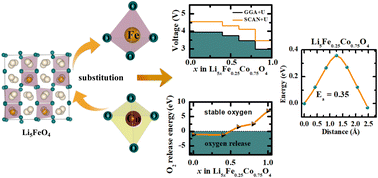Suppressing the initial capacity fade in Li-rich Li5FeO4 with anionic redox by partial Co substitution – a first-principles study†
Abstract
The increasing relevance of energy storage technologies demands high-capacity cathode materials for Li-ion batteries. Recently, Li-rich defect anti-fluorite Li5FeO4 has emerged as a high-capacity cathode material exhibiting simultaneous anionic and cationic redox without significant oxygen release but suffering from irreversible structural change and capacity fade during cycling. Herein we investigate the suppressed capacity fade reported in Co substituted Li5FeO4 and establish the optimal performance by tuning the concentration and oxidation state of Co using first-principles density functional theory calculations. We have substituted Co at the Fe site and carried out a detailed analysis of structural, magnetic, electronic, and electrochemical properties. The extended stability and suppressed capacity fading are found only in specific compositions depending on the Co/Li concentration and the oxidation state of Co. The reasons behind suppressed capacity fading in Co-substituted systems have been unveiled on the basis of bonding analyses and proposed as a strategy to suppress the voltage fading reported in Li-rich materials due to transition metal migration. From the evaluation of thermodynamic stability and the electronic structure, Li5.5Fe0.5Co0.5O4, Li5Fe0.25Co0.75O4, and Li4.5Fe0.5Co0.5O4 are found to exhibit better electrical conductivity than Li5FeO4. All these systems have voltages in the range of 3–5 V and exhibit a three dimensional Li diffusion pathway with a diffusion barrier height of around 0.3 eV. From Li5Fe0.25Co0.75O4, one can delithiate nearly three Li-ions without structural change and oxygen release, and therefore it is expected to acquire a reversible capacity of around 513 mA h g−1. Moreover, as in pristine Li5FeO4, the selected Co substituted systems also exhibit simultaneous anionic and cationic redox without significant O2 release. These results suggest that a tuned Co substitution in Li5FeO4 improves structural stability during delithiation along with promising voltage, electronic and ionic conductivity, eventually suppressing the initial capacity fade and providing high capacity and good kinetics.



 Please wait while we load your content...
Please wait while we load your content...